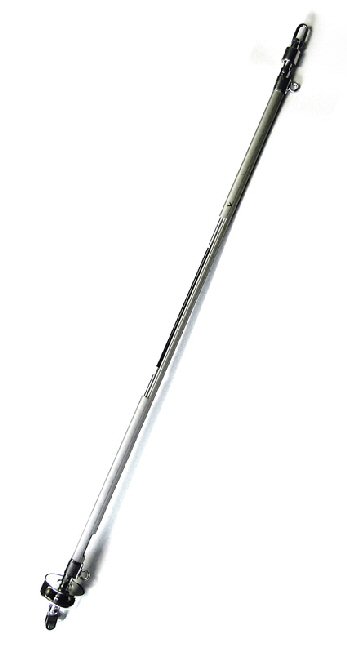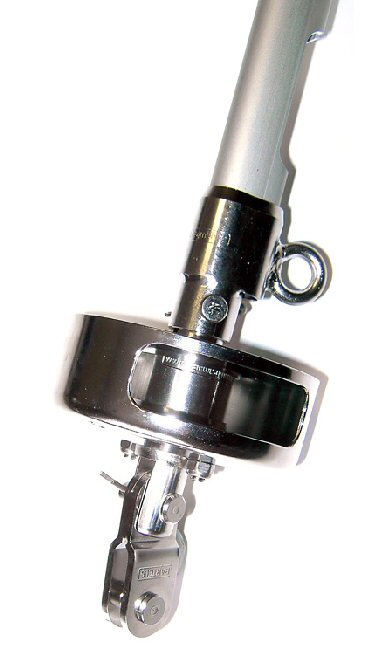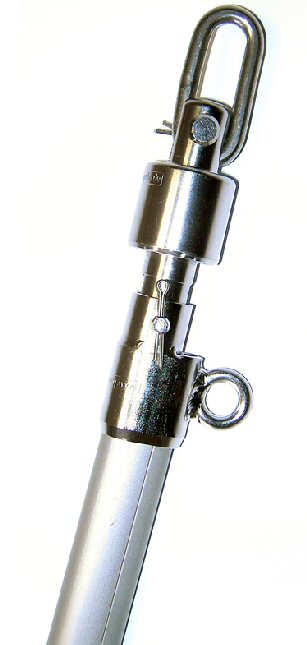| Ton
Jaspers brings a new "heavy air" solution: jib-trysail with bolt rope
and new furling gear From:
Wayfarer
To:
'KEN/K.H.Jensen'
Cc:
'Dick/Rich. C. Harrington' ; 'Frank W48 Wanderer Dye' ; 'Kjell W4878
Gjære' ; 'Ray Scragg' ; uncle-al3854@cogeco.ca
Sent:
Saturday, December 02, 2006 12:25 AM
Hi Ken,
Thank you for your kind email. As always,
it is well appreciated.
...
BTW, the full length boltrope in the genoa
is not the only change I had made. My genoa also has
a foam luff and
a deeper cut
bottom to compensate for the furler drum. It is designed to fit a
Bartels reefing-furler. Mr. Bartels
designed a
Wayfarer special last winter. The
final design will incorporate
my and Dick Harington's experiences with
the device. Then it will be
made available by Mr. Bartels as
a standard product. The reefing genoa has been developed
by Pinnell & Bax
(UK) and will
become available from them as a standard
cut as well.
   Above
you can see a few shots of the newly
designed reefing-furler that should become commercially
available any moment now. The design was
initiated by me, but full credit goes to Mr. Bartels of
Bartels GMBH, Germany: http://www.bartelsgmbh.de/ .
It was rigged by Ian Porter who made
a slight
adjustment to the halyard length, an extension wire for my
racing genoa (sailed
traditionally) and a safety wire for
the furler. The safety wire replaces the
forestay and runs from the
mast to the top swivel. Inside
the aluminum profile of the
furler, a 4 mm SS wire replaces the forestay.
So far, I am very pleased with
the reefing-furler and
the sail cut by P&B. The only issue is
that the safety wire is a little
too long. Once I have
determined its correct length, it will be included
in the package Bartels is going
to offer to the Wayfarer community. Every part of the furler
is made from stainless steel or
aluminum, there are no plastic parts. The design strength
of the swivel bearings was 32 kN which
is five times more than the standard forestay.
With the 5
mm wire inside the furler, this rig well exceeds
Wayfarer forestay strength standards.
Best wishes,
Med venlig Hilsen,
Ton
Jaspers W10445
-----
Original Message -----
From:
KEN/K.H.Jensen
To: Wayfarer
Cc: 'Dick/Rich. C. Harrington' ; 'Frank
W48 Wanderer Dye' ; 'Kjell W4878 Gjære' ; 'Ray
Scragg' ; uncle-al3854@cogeco.ca
Sent: Saturday, December 02, 2006 5:02 AM
Hi Ton,
Thank you very
much indeed ! I am very pleased
by your response and solid W utilization and
guidance. We
know the road to understanding is explanation and I was
in need hereof since I couldn't understand why my Dutch
W-friend Ton would (as
I was told a few times) be skeptical of the W-trysail
!
So, I am very
pleased that you took the time to write
and to include the very interesting new information re. safety and
efficiency as I like your ideas/approach to handling
the W. in rough conditons. This also confirms that new things can
be learned by a very old man like me - thank you very much !
My best wishes
and kind Wayfarerzeiler-regards to you and yours in NEDWA.
Ken |